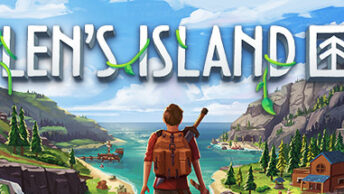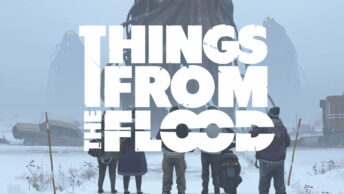Endzone – A World Apart is a post-apocalyptic city-builder with a heavy focus on survival. Although it suffers from pacing issues and underdeveloped systems, it’s well worth playing in its current state.
Type: Single-player
Genre: Survival, City-Building,
Post Apocalyptic
Developer: Gentlymad Studios
Publisher: Assemble Entertainment,
WhisperGames
Release date: 2 April, 2020


Introduction
Endzone – A World Apart is a post-apocalyptic city-builder that takes on after Banished with its focus on survival. I have not played Banished, but a cursorily look at its systems (and steam hub) tells me that this clearly is a “Banished-like” – that is, a game that is identical to Banished in its foundations. It does have significant added complexity (at least in the number of systems, not necessarily in how the game actually plays) and is obviously not a trivial clone.
In its current state, the game plays surprisingly well (it’s much more of a complete game than, say, Songs of Syx or even Before We Leave) and has quite a lot of content already. Admittedly, some of the content is a bit under-cooked and either dull or pointless, but that’s what Early Access is for!
I have to admit I had quite a lot of trouble with the game, early on. Part of this is probably because I’m new to the Survival city-building genre, part of it is likely because of the game’s pacing issues. The attrition was fruitful, however, and it’s the kind of demanding game I like – the kind that will prevent you from progressing until you’ve learned a particular mechanic or system, but once you’ve done it once, you can repeat it without much trouble – more on this in the Micromanagement section.
There is a surprising amount of content to structure gameplay – side missions, Scenarios (challenges with different objectives and starting conditions) and so on. For those less inclined for a purely sandbox kind of experience, there is a lot of content, although it can be a bit too monotonous as of yet – I’ll write more about it in the Pacing and Extras sections.
In Endzone, you are trying to create a thriving colony after a nuclear apocalypse. You start from nothing and you’ll feel in your skin how tough it is to survive. You’ll have to deal with droughts and, when the God given rains come, so does radiation.
The basics are fairly familiar to anyone who’s played a city-builder: you have several structures to gather and refine resources. Fishermen, Hunters, Gatherers, Lumberjacks, Scrap collectors (stone miners, really), and so on.
It starts diverging in Agriculture following Banished. Here you can have Fields and Orchards, the former for seasonal (or periodic) crops like vegetables and grains, the latter for perennial crops like fruit and nut trees. While I like this, I feel like there is room for growth. Although there are several different kinds of crops (potatoes, beans, corn, wheat, bell peppers, etc.), they are all essentially the same – the only variation is in growth times and yield; in most situations, you will choose the optimal yield/time crop and move on.
Extremely important is to manage water and radiation levels. This is micromanagement heavy, especially early on, when you don’t have enough people or resources to do everything.
You’ll have to conserve water when it rains, and use it for irrigation during droughts – or you can expect your harvests to be poor and your population to starve.
For radiation, you’ll have to pay attention to when your food and water sources are contaminated (including irrigation water!). Too much radiation and your settlers will become infertile, a death sentence for the colony – speaking from experience!
In the first stage, you’ll be worrying about basic water and food production, as well as tools and clothing. In the second stage, you’ll want to start doing Research, which can branch out into several directions. One is the Expeditions, the other is Electricity, which will boost the productivity of every building and citizen in your colony. Research also has other building-specific improvements or the newly added Decrees, on which I’ll write more in the Extras section.
The final point to note is that the behavior of your citizens is extremely important and building placement plays a huge, huge role. Citizens are individually simulated and have their needs and homes. If you don’t pay attention to building placement, they’ll spend too long walking to work or food and your productivity will be well below your expectations. More on this in the Micromanagement section.
I will now be focusing on the three points I found most important to the game’s current state: Pacing, Micromanagement, and the “Extra” systems (that fall outside the basic game mechanics).
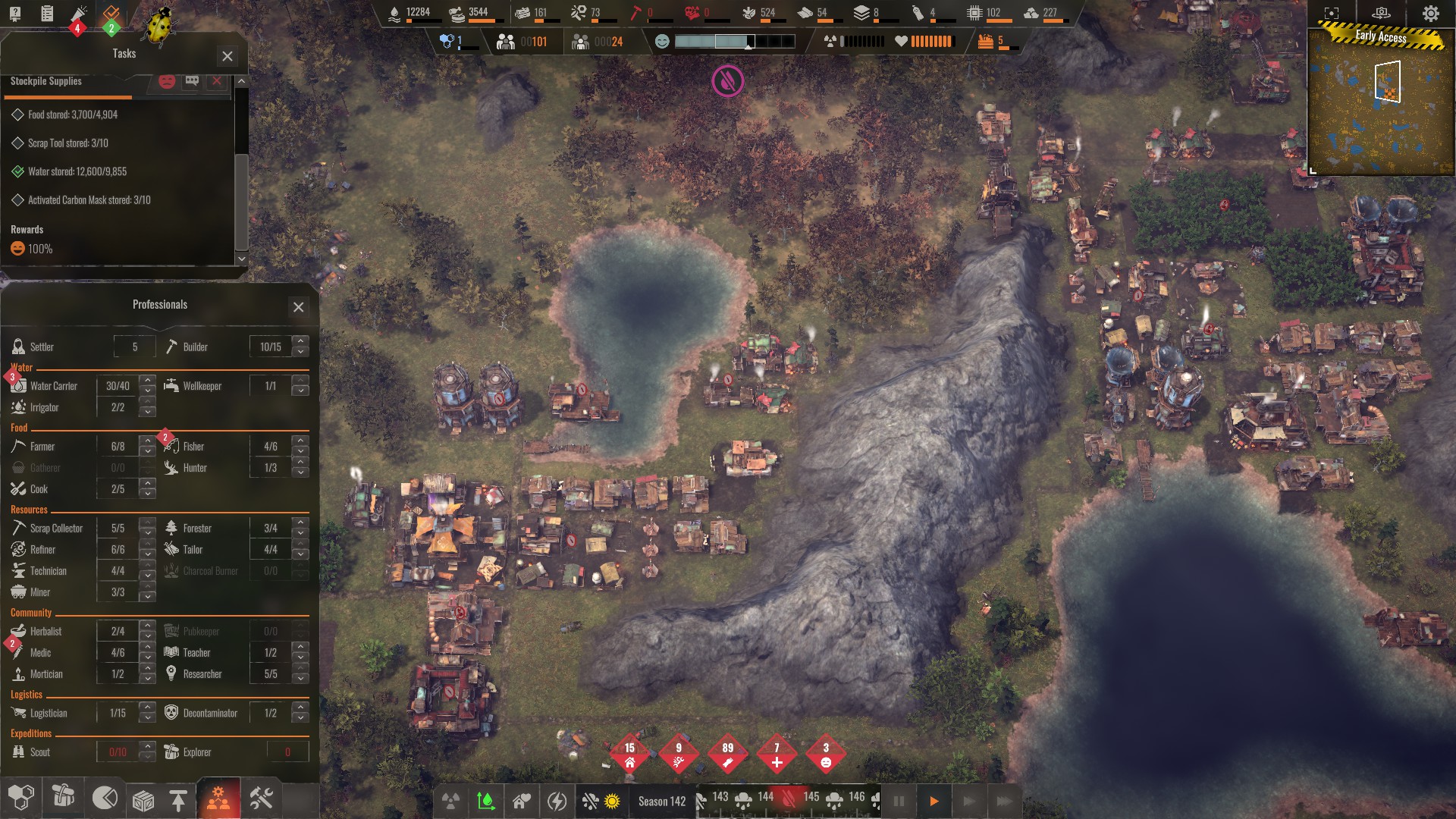
Difficulty and Pacing
This section is about the pacing of the game, and its difficulty in surviving. I hope this is not too particular to my situation as a newcomer to the survival city-builder genre – though players familiar with Banished may come better prepared than I did.
Here’s the thing: the game’s most difficult moment is the start, and I found it quite difficult indeed. My first 10-15 hours of play were all failures. But failures to get beyond the initial 30-50 colonists, which is the “early game”. Things seemed to be going okay, but eventually I lacked essentially everything – I had insufficient people for the available tasks, had insufficient food, water, excessive radiation, and so on.
It is also important to note that while the tutorial is thorough in giving you an overview of what each building does (in a rather abstract way, (understandably) lacking very important details), it also carries you through this difficulty barrier. The tutorial avoids any kind of resource shortage and guides you until you safely research technology that significantly boosts the productivity of your colony beyond the need to micromanage or think of details.
I believe this difficulty comes not from the high level planning (which buildings to build) but from the low level planning (where to build, in what order and, most importantly, where to allocate workers on a moment to moment basis). The problem is that the low level planning is much harder to learn. You don’t actually know who is working on what or why a worker is being much less productive than he should. Sure, you can select a particular workers and follow him around on his day, but the game lacks the tools to alert you that workers live too far from their workplace, that they are spending too long walking or looking for food instead of working, etc..
And this low level planning is the meat of the early game. Without understanding it, you will fail. This is clearest when you finally learn how to get over the barrier and, once past the initial hump, you’ll need *less* workers to produce *more* than you could early on. One inefficiency creates another and soon your whole colony is clogged up – this isn’t easy to see.
The real problem, however, is that there is essentially no challenge after the initial barrier. For example, once you have a couple of surplus workers, you can start researching. Assuming your resources are stable, you’ll soon be able to research the “kitchen”. This can amplify your food production by a factor of 10 – not 10% but actually 10x. You spend 10 raw food units to produce 100! Of course, this number is only ideal. In reality, you’ll never produce that much (citizens don’t favor processed food over raw food, so they’ll cannibalize the whole supply), but it gives you an idea of how much research really changes things.
At this point, you’ll get more surplus workers and will be able to produce more than enough of everything – food, water, medicine, radiation pills, and so on.
At this stage of the game, there is very little pressure. What you research isn’t too important (perhaps with a 2 or 3 priorities), and neither electricity nor expeditions will be too fundamental to the experience.
To conclude, the game is a bit of a one trick pony, at the moment. There is an interesting difficulty barrier at the beginning, “true” survival, but most of the mechanics actually come into play later on when survival is not really a problem (unless you try to expand too quickly – though even this only slows you down, because the population will simply drop for a while but not endanger the colony).
I found it quite good to learn how to get over the barrier (if very frustrating until I started looking into low rather than high level planning), but what follows is definitely undercooked.
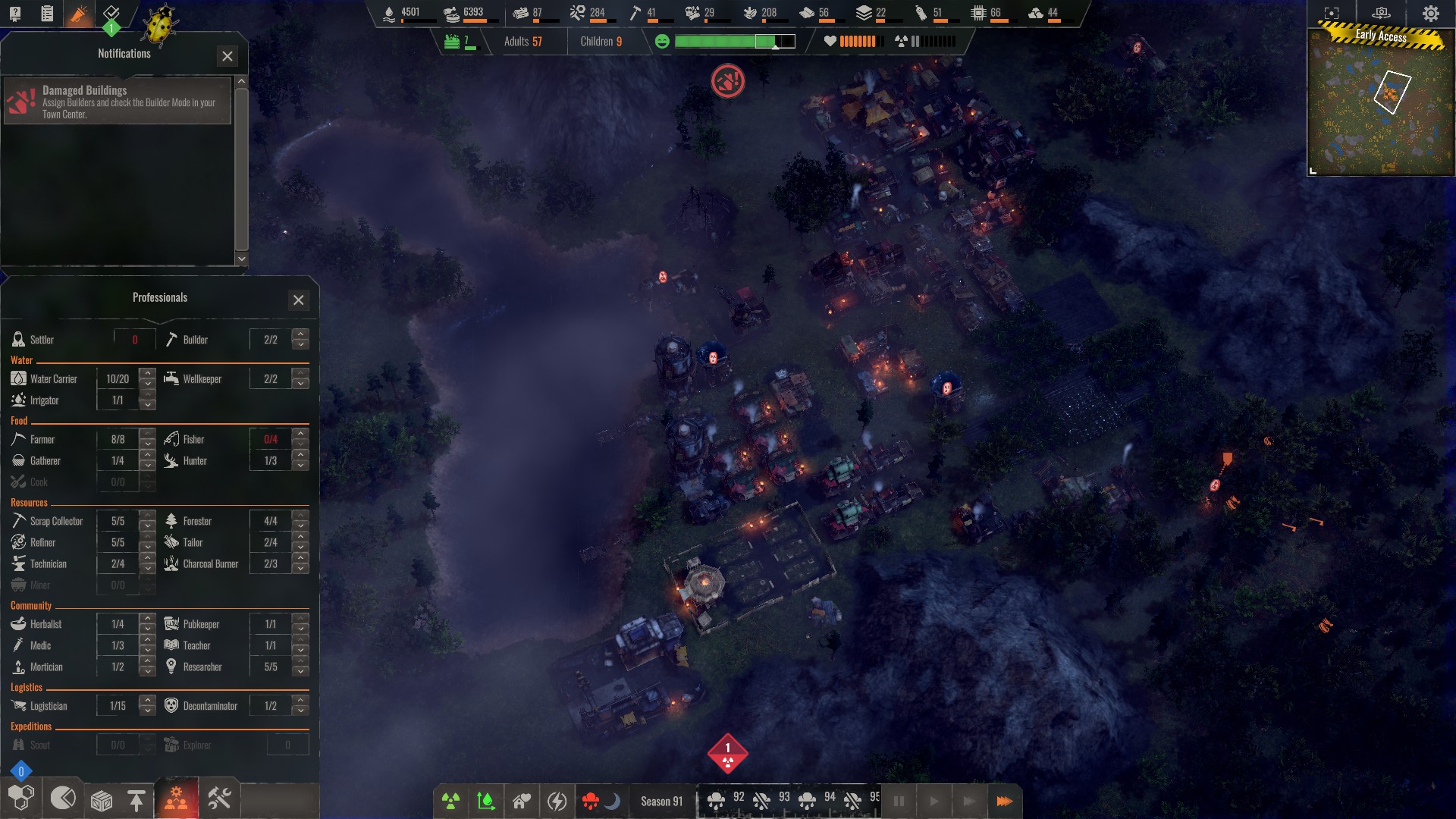
Micromanagement
I’ve already touched on Micromanagement, but I think it deserves a section to definitively carry the point home.
It is important for your workers to live close to their workplace (even though you don’t control individual assignments) and to have nearby food and water sources. If they don’t, they’ll spend time walking around instead of working, and you’ll fail to meet the production requirements to bootstrap your colony.
Unfortunately, the game lacks the tools to highlight micromanagement problems and really control some of the finer points (though that is being changed somewhat with the Decree system, see the next section). While there are very useful statistics and plots on population levels, age, resource production and consumption, and so on, it is very hard to diagnose or notice that something is going wrong on the micro level. Unless you follow individual workers around (and are explicitly looking for this kind of problem), you will miss worker-level (rather than building-level) inefficiencies.
This can play an important role in the mid-game, when you need to construct more housing for the extra colonists. Your initial area is likely to be full, and so you’ll need to construct a “second colony”, more or less. If you build only houses, you’ll see your production levels dropping despite having extra workers – because of the longer commute times.
Also very important, but mostly in the early game, is to constantly redistribute workers. You will *not* have enough workers, and so you need to be very frugal. Reallocate the fishermen during a drought into other food sources (hunting if there are animals around) or tool and clothing production to prepare for the radiated rainfall to come.
This was also not something I expected and thus made it much harder for me to understand why my early colonies failed.
To conclude, expect micromanagement early on. This may or may not be your thing, but it is what it is.
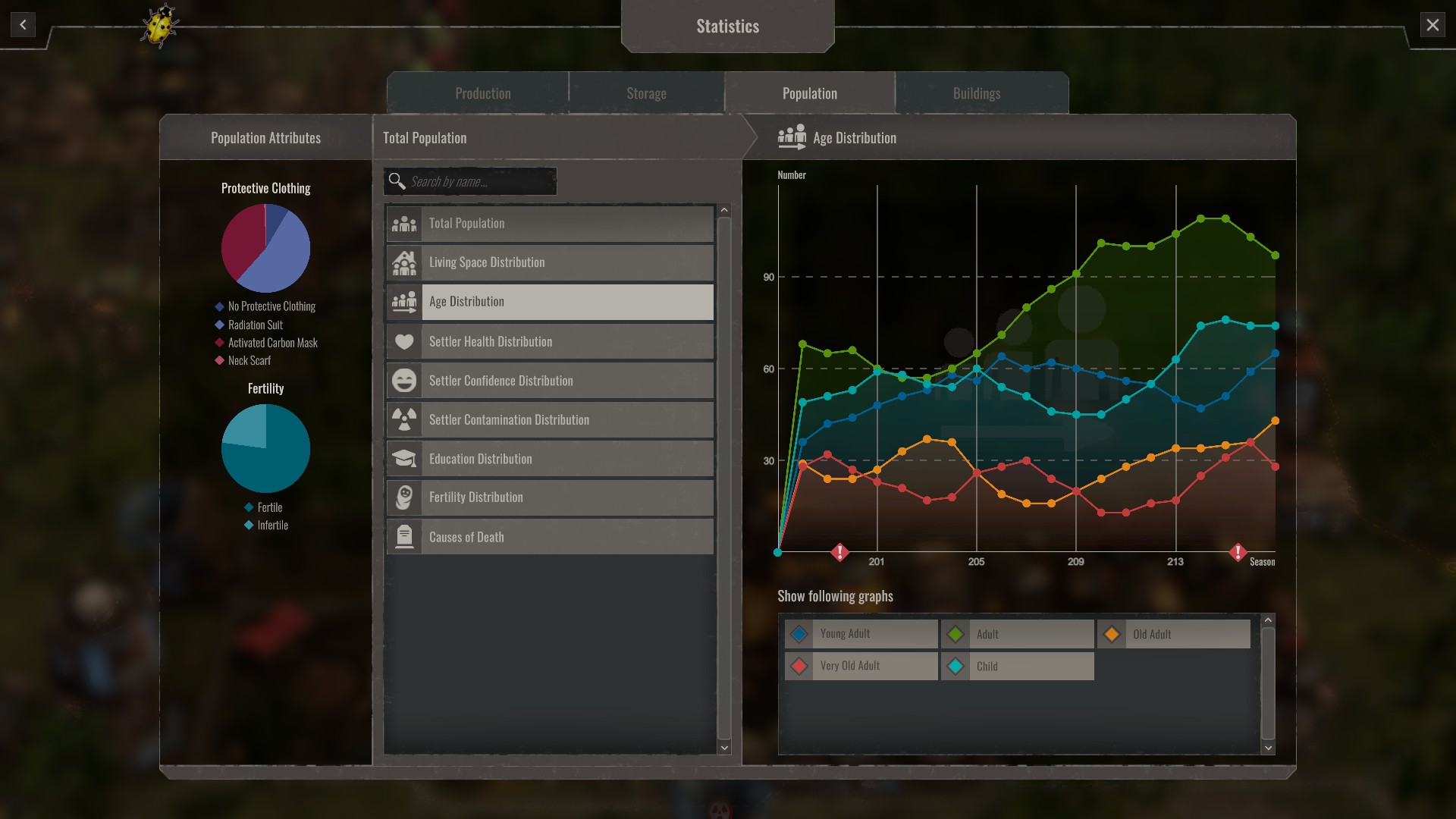
Extras – Scenarios, Expeditions, Decrees
The final aspect I want to touch on is the extra features and mechanics that make this game stand out from a traditional city-builder.
The most important of these are the Expeditions. There is a special-purpose building you can construct to employ up to 10 citizens to store extra tools, protective clothing, and food rations to send other people out into Expeditions. These are merely point on the world to which explorers travel to get resources (some are generic, others have a specific mini-story and resources like seeds, new citizens, etc.). While I really like the idea of Expeditions, they suffer from two problems.
The first is that they’re mostly useless. When you can afford the extra workers and equipment to go on expeditions, you’re likely well over the barrier and have no need for the meager extra resources you get.
The second is that the setup requires a bit too much micromanagement and gets quite tedious. This is because each expedition may require specialized explorers (an experienced farmer, doctor, etc.) or equipment. To launch an expedition you’ll need to browse through all the citizens to select which ones are desired, which tools and clothing to use, and so on. Then you wait for them to gather everything. Once it is, they set off on their expedition. If anyone dies for any reason, the expedition is cancelled and you must setup everything again. Once they arrive, you’ll have to instruct them by telling them which room to go to and so on. This is cool in the unique mini-story events, but not in most of them. Essentially, you just click “continue” several times, and occasionally “go back, go back, go left, continue”. The idea is cool, but the implementation lacks interesting choices.
Then, there are Decrees. Decrees were only introduced in the latest update, so they’re obviously under-cooked. These are basically colony-wide “crisis” orders for you to employ. These include rationing food and water, exiling children or old people, and so on. The idea of the decrees is cool, especially to give you some more micro control over some aspects of the game in times of crisis, but they seems a bit too blunt at the moment. It would be nice to have a resource specific system to tell workers not to use certain clothing or tools (sometimes you need them for timed side-quests) or eat specific types of food, etc., since these are aspects that are more relevant to the needs arising during play.
Finally, there are the Scenarios. These are basically different “challenges” for a new colony. Choosing a scenario includes a long-term objective (“collect X different kinds of seeds”, “reach X population”, “survive X worsening droughts”, and so on) and a different map and starting conditions.
I really like these! The only trouble is that several of them end up playing effectively the same, because they apply only to your actions after the initial barrier. Because everything is so stable after the initial barrier, the challenge is basically gone.
The overall point to take home from this is that the game’s innovative systems, currently, are under-cooked. This isn’t terrible news, though, since the game has more than enough time ahead to fix the problems.
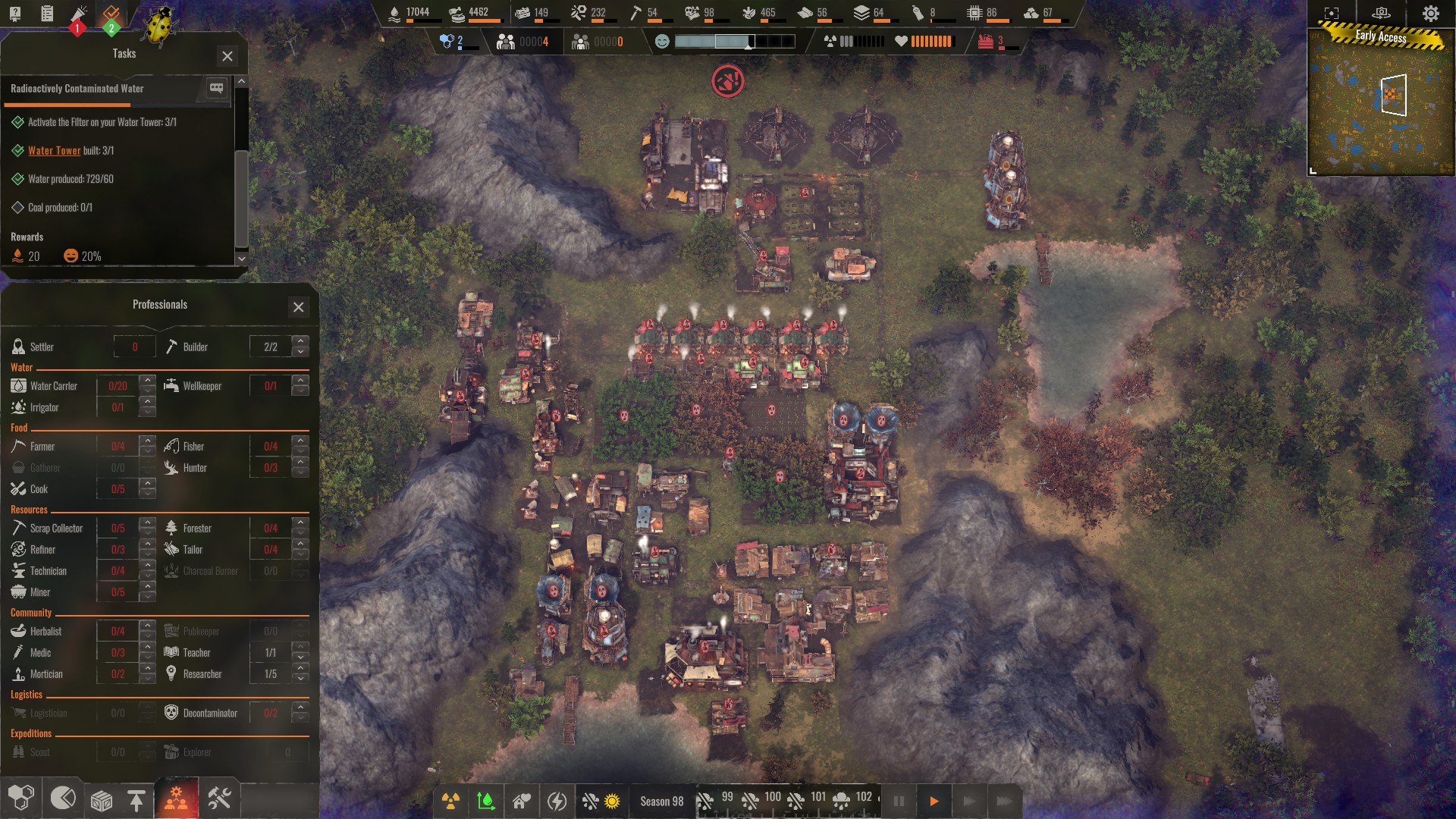
Conclusion
Endzone was a very pleasant surprise! It was a much meatier game than I expected, being early access. Sure, many of its mechanics still serve little purpose, but it has an extremely solid foundation that makes for a great early game.
It’s very playable and has many quality of life features that one would expect only at release.
As always, I recommend waiting for release, but anyone who likes to get in early can definitely pick this up. I’ll eagerly wait for the full release to see if it manages to flesh out its mid/late game and take it from a good to a great game.




